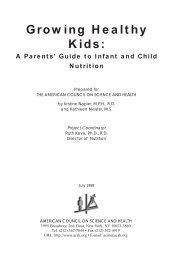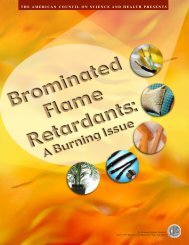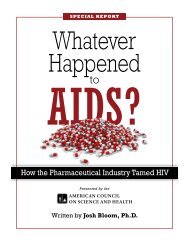The Role of Beef in the American Diet - International Meat Secretariat
The Role of Beef in the American Diet - International Meat Secretariat
The Role of Beef in the American Diet - International Meat Secretariat
Create successful ePaper yourself
Turn your PDF publications into a flip-book with our unique Google optimized e-Paper software.
<strong>The</strong> <strong>Role</strong> <strong>of</strong> <strong>Beef</strong> <strong>in</strong> <strong>the</strong> <strong>American</strong> <strong>Diet</strong><br />
32<br />
kill bacteria <strong>in</strong> beef and o<strong>the</strong>r red meats.<br />
Consumer acceptance <strong>of</strong> food irradiation is already fairly high; <strong>in</strong> a<br />
large survey conducted <strong>in</strong> several parts <strong>of</strong> <strong>the</strong> U.S. <strong>in</strong> 1998–99, 49.8%<br />
<strong>of</strong> adult respondents reported that <strong>the</strong>y were will<strong>in</strong>g to buy irradiated<br />
meat and poultry (67). O<strong>the</strong>r studies have <strong>in</strong>dicated that acceptance is<br />
even higher after consumers are educated about <strong>the</strong> food safety benefits<br />
<strong>of</strong> irradiation (65).<br />
<strong>The</strong> <strong>in</strong>creased use <strong>of</strong> irradiation to treat meat and poultry would<br />
have important benefits for consumers <strong>in</strong> <strong>the</strong> U.S.<br />
CONTEMPORARY ISSUES IN THE NEWS<br />
<strong>The</strong> next sections <strong>of</strong> this report discuss two diseases <strong>of</strong> cattle that<br />
have caused serious problems <strong>in</strong> some o<strong>the</strong>r parts <strong>of</strong> <strong>the</strong> world but that<br />
are not present <strong>in</strong> <strong>the</strong> United States. Comprehensive efforts are be<strong>in</strong>g<br />
made to keep both diseases out <strong>of</strong> <strong>the</strong> U.S. and to m<strong>in</strong>imize <strong>the</strong>ir impact<br />
if <strong>the</strong>y ever do appear. <strong>American</strong> consumers do not need to take ei<strong>the</strong>r<br />
<strong>of</strong> <strong>the</strong>se diseases <strong>in</strong>to account when mak<strong>in</strong>g food choices (except when<br />
travel<strong>in</strong>g to affected countries). <strong>The</strong> follow<strong>in</strong>g discussions are <strong>in</strong>cluded<br />
so that readers will be able to put news reports about <strong>the</strong>se diseases <strong>in</strong>to<br />
perspective and understand <strong>the</strong> precautionary measures that are be<strong>in</strong>g<br />
taken to keep <strong>the</strong>se diseases out <strong>of</strong> <strong>the</strong> U.S.<br />
X. Bov<strong>in</strong>e Spongiform Encephalopathy<br />
Bov<strong>in</strong>e spongiform encephalopathy (BSE), commonly known as<br />
mad cow disease, is a degenerative disease <strong>of</strong> <strong>the</strong> nervous system <strong>of</strong> cattle<br />
that results from <strong>in</strong>fection with an unusual agent. Current research<br />
suggests <strong>the</strong> agent that causes BSE is a “prion,” an abnormal prote<strong>in</strong><br />
with a novel mode <strong>of</strong> replication and transmission (68). Cattle may contract<br />
<strong>the</strong> disease from feed conta<strong>in</strong><strong>in</strong>g animal byproducts contam<strong>in</strong>ated<br />
with this prote<strong>in</strong>. It takes a long time — probably years — for <strong>in</strong>fection<br />
with this agent to produce detectable symptoms. Prions are very hard to<br />
destroy; <strong>in</strong> comparison with viruses and bacteria, <strong>the</strong>y are unusually<br />
resistant to heat and radiation. <strong>The</strong> abnormal prion is found almost<br />
exclusively <strong>in</strong> <strong>the</strong> bra<strong>in</strong>, sp<strong>in</strong>al cord, eyes, and lymphoid tissue <strong>of</strong><br />
affected cattle; it is not present <strong>in</strong> muscle tissue (meat) unless this tissue<br />
has become contam<strong>in</strong>ated with nervous system tissue, and it is not present<br />
<strong>in</strong> <strong>the</strong> animal’s milk.<br />
Diseases similar to BSE occur <strong>in</strong> o<strong>the</strong>r species. One <strong>of</strong> <strong>the</strong> best<br />
known is scrapie, a relatively common disease <strong>of</strong> sheep that does not<br />
threaten human health. <strong>The</strong>re are also several human spongiform










